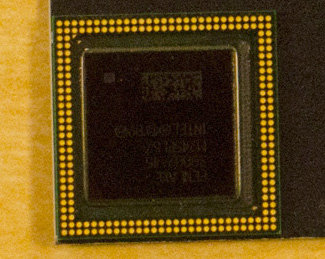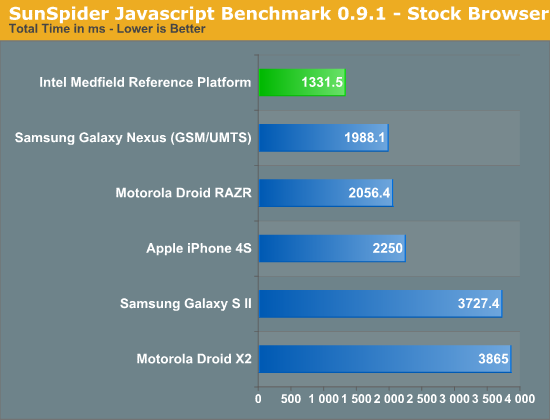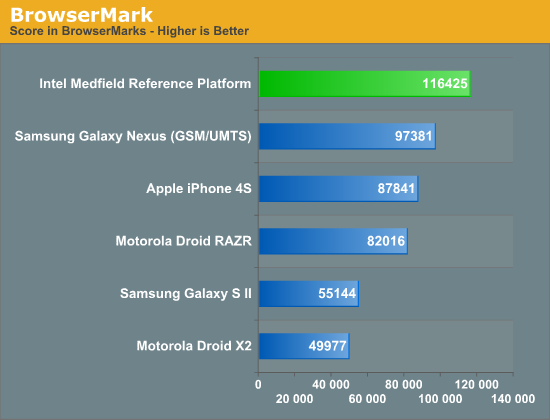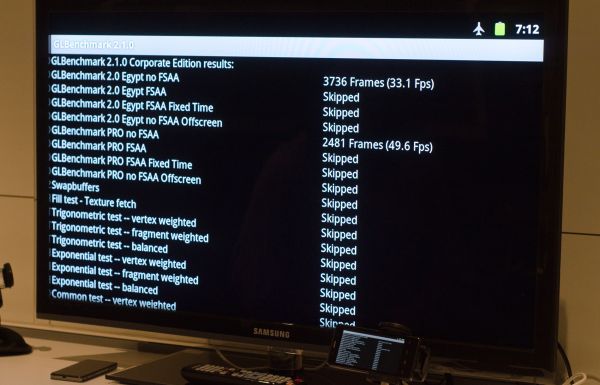Intel's Medfield & Atom Z2460 Arrive for Smartphones: It's Finally Here
by Anand Lal Shimpi on January 10, 2012 8:00 PM ESTIt's here. Intel's first smartphone SoC that you'll actually be able to buy in a device before the end of the year. The platform is called Medfield and Paul Otellini just announced its first device partners.
Medfield starts out as a bonafide mobile SoC. Whereas Moorestown was a "two-chip" solution, Medfield is just one - the Penwell SoC:

The SoC is only available in a PoP (Package on Package) configuration measuring 12mm x 12mm. Intel wouldn't give out a die size but it did show me a Penwell sample without the stacked DRAM:

Since I know the measurements of the package I could estimate the dimensions of the silicon itself. My math worked out to be around 62mm^2. That's larger than a Tegra 2-class SoC, but smaller than Tegra 3 or Apple's A5. The diagram of its high level architecture above helps explain why.
There's only a single version of Medfield being announced today: the Intel Atom Z2460. The Z2460 features a single Atom core with a 512KB L2 cache, a PowerVR SGX 540 GPU and a dual-channel LPDDR2 memory interface. In a world where talking about four Cortex A9s and PowerVR SGX 544MP2s isn't uncommon, Medfield starts out almost sounding a bit...tame. But then you see its performance:

Although running what appears to be a stock Gingerbread browser, Intel's Medfield reference platform posts SunSpider performance better than any other smartphone we've tested - including the Galaxy Nexus running Ice Cream Sandwich. Intel promises that Medfield's performance will scale on ICS as well - the gap should be maintained. We've seen high results from reference designs in the past, but the Medfield platform is a little different as you'll soon see - it's a complete smartphone design that should be representative of handsets that hit the market later this year.
Medfield isn't a one trick pony either, performance is similarly dominating under BrowserMark:

These are tablet-like scores. Here the Galaxy Nexus running ICS comes close, but once again Intel expects that on the same OS Medfield should be faster than any of the currently available SoCs.
I asked Intel where its SunSpider and BrowserMark performance advantages came from, especially considering we've typically only seen huge gains with new browsers and not new SoCs. Their response pointed to a bunch of factors, but one stand out issue was the A9 has a great execution core but seems to be more limited on the memory interface. Atom can support far more outstanding misses in L2 than the Cortex A9, which chokes bandwidth to the processor for anything not already in the L2 cache. This may be one of the reasons why we've never been able to get really high bandwidth numbers out of A9 based SoCs. It's probably safe to assume that things will be different with the Cortex A15, but for now it's little things like this that give Medfield a performance advantage.
GPU performance is understandably not as impressive. We couldn't get offscreen numbers of GLBenchmark 2.1 but we did get results at the device's native resolution (1024 x 600):
3D performance is better than the OMAP 4460 due to Medfield's 400MHz GPU clock compared to ~300MHz in most OMAP4 devices.
Performance without power considerations is meaningless, especially in the smartphone world. Luckily for Intel, Medfield seems very competitive there as well. Intel provided some power and performance data for Medfield based on its reference platform. I still haven't been able to verify any of this for myself, but I was able to see some power tests run in person on the reference platform and competitive devices.
The Intel provided values are pretty astonishing . Sub 20mW idle, sub 750mW during a call on 3G and although not pictured here, Intel's internal data suggests ~1W power consumption while browsing the web compared to ~1.3W on the iPhone 4S and Galaxy S 2. I've done my own measurements on 4S web browsing and came up with a very similar value.
| Intel Measured Smartphone Power Consumption (Identical Display Brightness) | ||||||
| Standby (3G) | Talk (3G) | Browsing (3G) | Video Playback 720p | |||
| Apple iPhone 4S | ~38mW | ~800mW | ~1.3W | ~500mW | ||
| Intel Medfield Reference | ~18mW | ~700mW | ~1.0W | ~850mW | ||
| Samsung Galaxy S II | ~19mW | ~675mW | ~1.2W | ~650mW | ||
The performance and power data both look great for Medfield. You would think that this data, assuming there's nothing fundamentally wrong, would be enough to convince a handset maker to actually give Intel a shot. You'd be right.
In addition to disclosing Medfield performance data, Intel is also announcing partnerships with both Motorola and Lenovo. The former is a broad, multi-year agreement stating that Motorola plans on creating many devices based on Intel silicon - the first of which will be a smartphone due out before the end of the year. Tablets will follow at some point as well.
Lenovo on the other hand will actually be taking and tweaking Intel's own Medfield reference platform, and releasing it in China in Q2.
All of this is exactly what Intel needed: a start.











164 Comments
View All Comments
Penti - Wednesday, January 11, 2012 - link
And it doesn't matter since the SoC's or rather CPU's aimed at Windows x86/64 tablets and Windows appliances does have SGX545. Windows 8 and Windows Phone (CE based) are two totally different OS's any way and Windows Phone is having a hard time just to support Qualcomm Snapdragon S1 and S2. I don't want to run Windows 8 Ribbon/MFC/WPF software on a phone platform neither do you. Microsoft won't support Windows Phone on x86. Microsoft won't support Windows 8 on this.They will as in Microsoft on Cedar Trail-M if PowerVR and Intel which have to ship them ever get their poor Windows drivers working. PowerVR/ImgTec aren't known for their Windows driver quality.
In a tablet and even tablet-PC (which Microsoft is still going for) it's mostly the screen that uses power. It doesn't matter if the cpu and chipset uses the 5W TDP plus 2.1W TDP it's still more power efficient then anything else running Windows (NT). It's just a few watts and a screen that will use just as much if not more power. In a phone on the other hand you can't have massive batteries and screens.
Intel is aiming the SoC towards Android handsets and tablets i.e. pads not tablet-pcs. They don't list DX support or even Windows Embedded support. Neither does it support more then 1GB of ram. It's built to interface with modem (baseband), LPDDR2, HDMI, MIPI-DSI, USB Phy, eMMC, with camera modules not with ordinary PC hardware topology of DDR3, PCI-e, LVDS/eDP, South bridge chipsets containing basic I/O. As well as support for USB, ethernet, SATA and whatnot in the SB. Memory will come included in the package too. Simply another platform.
Not for powering Office 2010 and Visual Studio 2012. Look for other chips there.
MySchizoBuddy - Tuesday, January 10, 2012 - link
This would be very interesting if it is launched TODAY not end of year.tipoo - Tuesday, January 10, 2012 - link
Yeah, that's why I'm wondering how it will perform against chips its actually going to compete with, namely Cortex A15 designs. The gap here is pretty big, but not insurmountable I think, and the A15 looks promising as well.tipoo - Tuesday, January 10, 2012 - link
Colour me impressed! This looks like it will be a rather disruptive SoC, especially with ARM Binary Translation. The nice thing is its a single core so developers don't have to optimize for two or four cores to get maximum performance. Although, I wonder if something like the quad core Tegra 3 would be able to best its performance if everything was more optimized for multicore? And more importantly, how will it fare against Cortex A15 designs. But, yeah, I'm excited for this, even more so for the variant with the 543MP2.Morg. - Thursday, January 12, 2012 - link
ARM binary translation will be slow ... like real slow.It's like a VM but on a different arch.
The tegra3 is just slightly slower .. on 40nm
Against A9 on the same process, ARM wins, against A15 ARM butchers.. nothing really different in the end - just that Intel can only count on process advantage to keep more or less in the race (so far).
milli - Tuesday, January 10, 2012 - link
Jason, yes I'm talking to you Jason Mick: oh how much you look like a fool now. Many people (including me) tried to warn you about your wrong article.DigitalFreak - Tuesday, January 10, 2012 - link
Wrong site, foo.Iketh - Tuesday, January 10, 2012 - link
I was thinking about that the entire time I was reading this.bji - Thursday, January 12, 2012 - link
What are you guys talking about?mikeepu - Thursday, January 12, 2012 - link
At first i thought the same thing as DigitalFreak, but i thought about it and went back to Jason Mick's article last month http://tinyurl.com/JasonMicksMedfieldArticle and found your comment. Yes. Yes, you did.